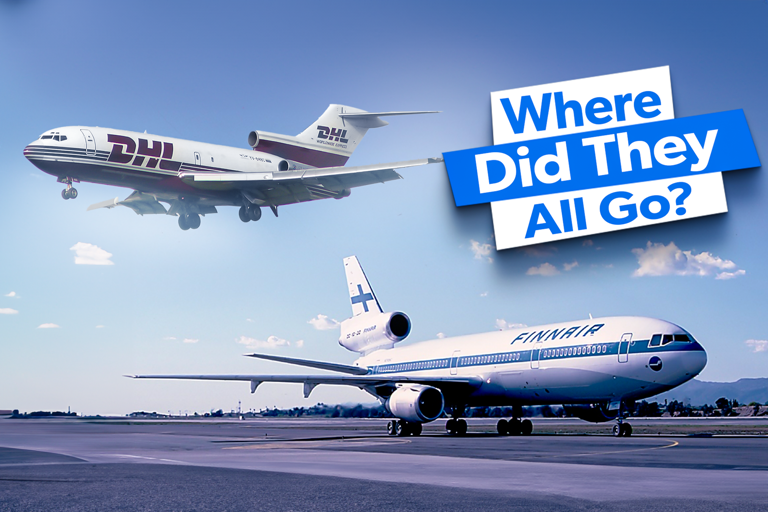
Table of Contents
- Tri-jets, such as the DC-10, were well liked for their straightforward engine arrangement and efficiency.
- Between 1970 and 1990 the number of CF6-powered dual and tri-jet orders was about the same.
- The Fokker 100 is still flown by smaller carriers even though the rear-engine aircraft is difficult to maintain.
Between the 1970s and 1990s, many major airlines added Tri-Jets to their fleets due to their growing popularity. The most notable versions have been replaced by more widely used dual-engine aircraft such as the Boeing 767, 787, 777, or the Airbus A330 and A350. Let’s take a look at their past to see what made them famous so recently.
The Tri-Jet, known as the second-generation aircraft, was considered to be significantly less economical than the already common two-engine but far more efficient than the quad-engine aircraft. The McDonnell Douglas DC-10 and MD-11, which are good for medium and long-haul flights, install their third engine in a “straight through” configuration, which cuts across the rear of the aircraft. This made installation and adjustment easier, and passengers commented that the cabin was much quieter as a result. But this made the rear of the aircraft heavier, which hampered overall handling.
With the engine mounted at the rear of the aircraft, the aircraft doors can be centralized to facilitate faster take-off and landing. Better takeoff performance will also increase aircraft efficiency for airports in “hot and high” areas.
Today’s obstacles
Due to their high operating costs and the implementation of ETOPS, large tri-jets are no longer in service. Prior to ETOPS, the only aircraft that could fly long distances over high seas were the older Tri and Quadjet models; However, when more modern, practical aircraft became available, interest in the tri-jet eventually waned. Between the 1970s and 1990s dual and tri-jet aircraft were at almost equal levels for orders, with various models of the following becoming successful in the market; All of these aircraft were primarily powered by General Electric CF6 engines:
Dual engine
- Airbus A300
- Airbus A310
- Airbus A330
Tri-jet
- DC-10
- MD-11
Smaller aircraft
Another well-known rear-engine aircraft, the small Fokker 100, is still flown by many carriers. The Fokker 100 was a regional jet manufactured by Fokker, a Dutch aviation manufacturer. It was derived from a smaller version of the Fokker 28, another rear-engine variant. It was first unveiled in 1983 and made its maiden flight on 30 November 1986. Swiss Airlines was the first operator of the 100 version, before American Airlines placed an order for the 75.
By 1996, the Fokker 100 had been produced and delivered 283 times. But Fokker is not giving up yet. Although this has not yet happened, the aim is to bring the aircraft back into production with better engines and overall performance.
Widebody tri-jets
With ten McDonnell Douglas MD-11s, Dutch airline KLM was the last commercial passenger operator of the aircraft and perhaps one of the most famous tri-jet operators. From 1993 to 2014, it operated and can often be seen flying on routes such as Amsterdam Airport Schiphol (AMS) to Montreal-Pierre Elliott Trudeau International Airport (YUL).
The MD-11 was developed from the DC-10, gaining an 11% longer fuselage and new engines. It has a range of 7,130 nautical miles (13,200 km; 8,210 mi), can carry 298 passengers, and includes a glass cockpit that eliminates the need for a flight engineer.Read more about the benefits of a glass cockpit here.
The MD-11 was produced in five different versions.
MD-11
The passenger variant was built between 1988 and 1998. 131 were built, and operators included American Airlines, Delta, Swissair, Japan Air Lines, and KLM.
MD-11C
With just five of these combi aircraft, this variant was built with the functionality of passengers and cargo on its main deck. Its main deck could accommodate up to 10,904 cubic feet of precious cargo.
MD-11CF
Only six of these convertible cargo planes were built when ordered by Martinair, a Dutch cargo airline. It could be adapted for full passenger and all cargo operations and had a port-side entrance at the front.
MD-11ER
Compared to the MD-11, this extended-range version could fly an additional 400 nautical miles, or 7,240 nautical miles (13,410 km; 8,330 mi), when it was first introduced at the 1994 Singapore Air Show. Three of these aircraft types were once flown by Garuda Indonesia.
MD-11F
Introduced in 1986, the cargo-only version had the same port-side door size as the MD-11CF. FedEx Express and Lufthansa Cargo were the major operators, with a maximum payload capacity of 200,151 pounds (90,787 kg) and the ability to transport up to 26 pallet loads.
READ | jet engine : How does the process of starting a jet engine work?
READ | Why Retract Forward the Nose Wheels on Aircraft?
READ | RPM: What does critical RPM of an aircraft engine mean?


3 thoughts on “The history of tri-jets and rear-engined aircraft and how they got away”